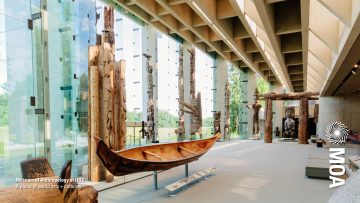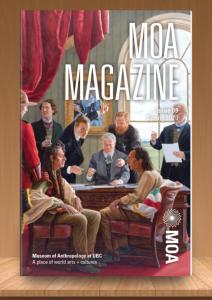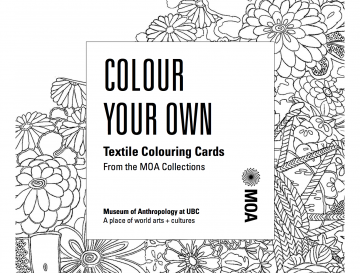As education continues to adapt to the new realities of digital engagement, The Museum of Anthropology (MOA) provides virtual ways to stay connected with art. While we move through this digital era, having access to art from anywhere gives us daily doses of culture and delight. MOA encourages us to keep art, culture and heritage in our daily life by expanding our minds and keeping our spirits high. This week we will explore just a few ways that we can connect, learn online and experience MOA From Home. To start our exploration, let’s take a Virtual Tour of the Great Hall! Experience a 360° virtual tour of the stunning Great Hall and read more about the massive carvings that fill it.

Photo by Cory Dawson. Courtesy of Museum of Anthropology at UBC.

From the comfort of your home, you can also discover nearly 50,000 objects in the MOA Collections Online! Search through different objects by places, peoples, cultures, categories, and even time. Or, explore by keyword to uncover something new. Examine the MOA Archives Online where you’ll find historical documents and photographs about the Museum, First Nations of the Pacific Northwest, the history of British Columbia, along with many other surprising gems. To learn more read the MOA Digital Publications + Sourcebooks which include:
- MOA Sourcebooks focus on objects, artists or areas of cultural significance, and serves as an important introduction to the work of the Museum and its community partners.
- Museum Notes provide supplementary content related to different exhibitions and installations.
- MOA Magazine a twice-annual print publication with rich stories from behind-the-scenes and in-depth profiles of objects and artists, and special projects.
To support the work of teachers, parents and caretakers, MOA’s Education department has been busy compiling lesson ideas that bring world cultures, new ideas and new experiences digitally. These resources can help students stay engaged virtually with art. Last year we featured a post about the Musqueam Teaching Kit, a wonderful digital resource to learn from xʷməθkʷəy̓əm (Musqueam) culture. MOA’s online Teacher Resources also offers two amazing educational websites:
- Voices of the Canoe: Learning about the canoe traditions of the Fijian, Squamish, and Haida helps us understand the historical and ongoing importance of canoe culture for these Indigenous peoples. This website presents a range of evidence – photographs, maps, interviews, historical texts and short films.
- One Mind, One Heart: Learn about the fierce opposition by the Heiltsuk Nation to the proposed Enbridge Northern Gateway pipeline and oil-tanker traffic in their ancestral waters. The website features films, photos of Heiltsuk territory, and community protests during the Project Review Panel’s visit to Bella Bella.
As we continue to engage with online learning, why not add a bit of MOA to your next virtual meeting? Change up your background and have your next gathering against the stunning backdrops of MOA’s iconic Great Hall and museum grounds. Select five beautiful MOA Virtual Backgrounds so you can imagine/foresee yourself at the Museum of Anthropology. You can also download and print these MOA Textile Colouring Cards, which feature patterns from textiles in the MOA Collections. These are simple and meaningful activities to do with children and youth as they learn about art.

Speaking of meaningful activities, Home Rhythms with MOA is a music lesson series offered to people of all ages. Hosted by MOA Public Programs Assistant and music teacher, Olivia Shaw, these educational videos demonstrate the process of building collaborative music at home. Through these short lessons, explore the possibilities of learning through storytelling, music and play. Along the way, learn about percussion and harmony, while exploring world cultures through music. In the video below Olivia Shaw and Balam Axayacatl Santos Antonio, an Indigenous artist from the Nahua people of El Salvador, teach us to make a collaborative song using only body percussion and layered vocals. You can watch all episodes on MOA’s Youtube Channel.
MOA has also developed an original documentary series called Knowledge Keepers. See the land currently known as British Columbia in ways you’ve never seen it before as traditional Indigenous knowledge keepers give us an inside look at the world we live in—through the eyes of a person who has thousands of years of oral history in their ears, and thousands of years of tradition in their blood. Three special knowledge keepers from the traditional and unceded territories of the Sechelt (Shishá7lh), Squamish (Skwxwú7mesh) and Musqueam (xʷməθkʷəy̓əm) teach us about the ancient art traditions of cedar harvest, Indigenous plants and salmon fishing. In a world of great unrest from environmental struggles, listening to the voices of Indigenous knowledge keepers are essential for our survival.